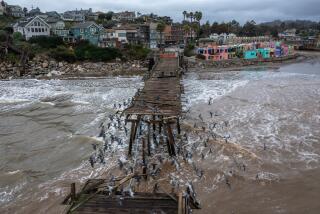Problem Still Exists at Oceanside Harbor
- Share via
The Coast Guard’s Local Notice to Mariners has warned for several months of the hazard to vessels negotiating the mouth of Oceanside’s harbor because of shoaling. In foul weather and during heavy surf conditions, a vessel can become unmanageable when passing through the jetties.
Nonetheless, tragedy struck late last month when an experienced Oceanside sailor, Frank Lucksinger, 67, was killed when the boat he was sailing was struck by a large wave. He was crushed against the rocks of the Oceanside jetty.
Lucksinger was aboard the 30-foot sloop, Pudmuckle, with six other crew members when the large wave hit, shoving her to the entrance of the south jetty. A second wave broke off Pudmuckle’s rudder. The yacht, owned by Larry Long of Poway, was broken apart when she struck the rocks. The other crew members were thrown into the water from where they were rescued by harbor patrolmen.
This latest tragedy (there have been other accidents during the past five years in this treacherous harbor mouth when the sea lumps up) emphasizes that some workable solution to make this entrance safer for navigation should be undertaken soon.
Frequent dredgings, according to Coast Guard spokesman, is not a permanent solution because of the “unbelievable cost.” He says that the Army Corps of Engineers, whose responsibility it is to solve because it is a navigable channel, is working on the problem. The Corps has conducted dredging operations about every 18 months to little avail.
Donald G. Spencer, chief of the southcoast section, Coastal Resources Branch of the Army Corps of Engineers, said that development work has begun at last on what is called the Oceanside Harbor Experimental Sand Bypass System. Congress authorized construction of the experimental project in 1982.
When the first phase of the system is completed in late 1986, it will consist of a series of stationary pumps to move sand elsewhere. One jet pump will be located at the shore end of the breakwater. Two more such pumps will be installed at the entrance channel. Construction has just begun on a discharge pipeline, designed to carry 100 cubic yards per hour, extending down the coast to Tyson Street.
More to Read
Sign up for Essential California
The most important California stories and recommendations in your inbox every morning.
You may occasionally receive promotional content from the Los Angeles Times.










